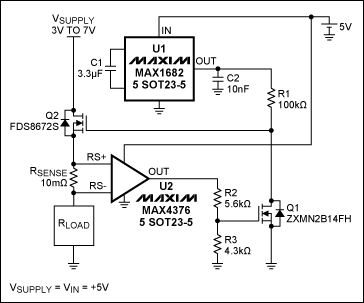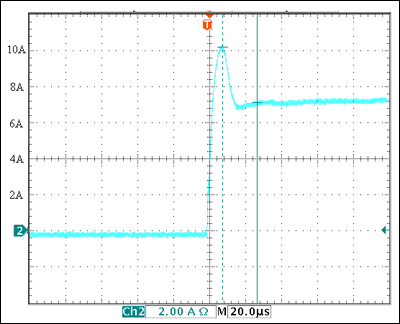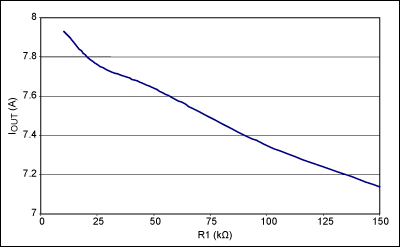
A similar version of this arTIcle appeared in the May 18, 2009 issue of EE TImes magazine.
Available integrated circuits can let you program a current limit, but they generally involve microcontrollers or data converters (or both). As an alternaTIve, the Figure 1 circuit lets you program a current limit without the intervenTIon of microcontrollers or data converters. It consists of two miniature SOT-5 devices and a few external components. The sense-resistor value determines the maximum current limit.

Figure 1. This circuit limits the RLOAD current to a value determined mainly by R1.
The circuit consists of a charge-pump voltage doubler (U1, MAX1682), a current-sense amplifier (U2, MAX4376), and two n-channel MOSFETs. U1 doubles the supply voltage to provide gate drive for Q2, and U2 amplifies the voltage across the sense resistor (RSENSE) with a gain of 20. This U2 output drives the Q1 gate via the R2/R3 divider, which modulates the current through R1, which in turn sets the Q1 drain voltage and Q2's gate-drive voltage.
U2's output voltage is 20 times the voltage between RS+ and RS-, but has a full-scale limit of 2V. Figure 2 shows the response of this circuit when you suddenly impose a heavy (low resistance) load. It allows an initial current surge to 10A, and then (after 20µs) settles to the desired limit of 7.25A.

Figure 2. With VSUPPLY and VIN (at U1) equal to 5V, the Figure 1 circuit limits load current to 7.25V.
The maximum allowed in-rush current is set by the sense resistor. A 10mΩ value, for instance, allows a maximum in-rush current of 100mV/10mΩ = 10A. This steady-state limit is determined by the operating characteristics of Q1 and Q2, together with the values chosen for resistors R1–R3. Figure 3 shows the ILIMIT values obtained by varying R1 alone. To set other values of ILIMIT, you can vary the ratio R2/R3 while holding the R1 value fixed.

Figure 3. With VSUPPLY and VIN (at U1) equal to 5V, the Figure 1 circuit's steady-state current limit varies with R1 as shown.
欢迎分享,转载请注明来源:内存溢出

 微信扫一扫
微信扫一扫
 支付宝扫一扫
支付宝扫一扫
评论列表(0条)